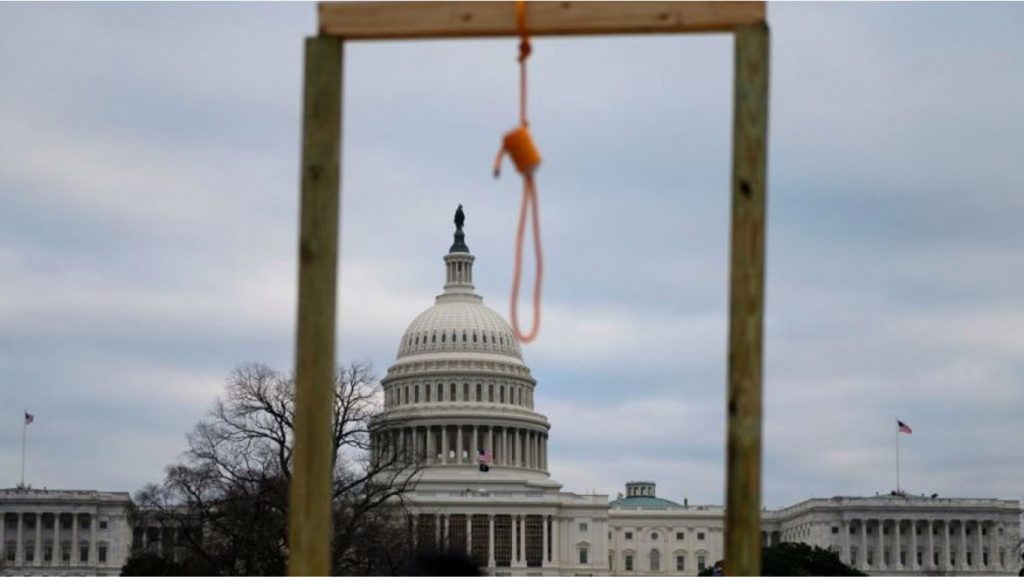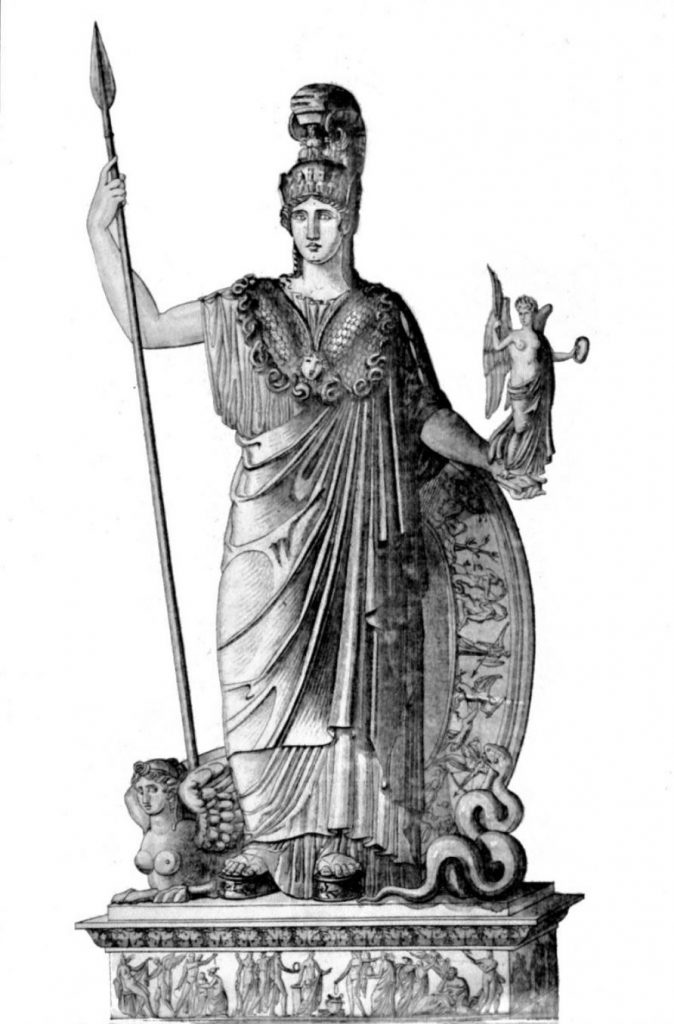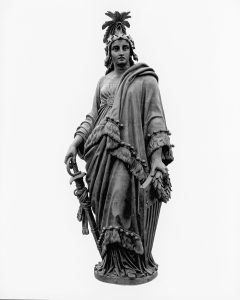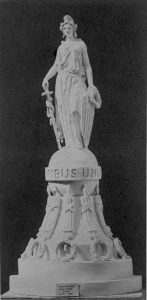White Supremacy, Lynchings, and Thomas Crawford’s Statue of Freedom
During the January 6, 2021, riot in which the pro-President Trump mob stormed the US Capitol building, someone erected gallows with a noose facing the west side of the building. Photographer Andrew Caballero-Reynolds shot the scene from the platform looking across at the Capitol. The image circulated widely on many internet sites and in the television news (fig. 1).

The gallows function as a picture frame directing visual attention to the statue atop the dome in the distance: Thomas Crawford’s Statue of Freedom (1855–63; fig. 2). Senator Ben Sasse (R-NE) observed two days after the insurrection, “All over the world . . . when people think about freedom, they see the dome of the US Capitol in their head.”1 Although Sasse did not name Crawford’s monument, its figural visualization of freedom contributes to the dome’s association with this abstract concept. The way in which the noose hangs in front of the dome suggests that the figural sculpture serves as a stand-in for the possible lynching victims, in this case, the building’s occupants—the elected members of Congress—who might have been paraded through the crowds and then hanged as a mass spectacle.
One of Crawford’s initial designs shows the statue as a female figure who wears the Phrygian liberty cap (also referred to as a pileus) (fig. 3).2 The articulation of a concept as a personification of liberty derives from antiquity, where it first stood for personal freedom in relation to manumission. The personification became codified in seventeenth-century emblem books and was subsequently used during the American and French Revolutions.
As the rioters scaled the outside of the US Capitol, I suspected that not only did they not have respect for the law, but they did not respect the works of art located inside and outside the building—nor did they understand the meaning of those works, especially Crawford’s Statue of Freedom, whose history is intertwined with the Civil War. Between 1853 and 1857, Jefferson Davis, the secretary of war and future president of the Confederacy, oversaw the construction and decoration of the Capitol Extension. This slave owner, congressman, and senator from Mississippi vehemently argued for extension of slavery into newly acquired western lands. He also used his cabinet position to occlude references to slavery by accepting, rejecting, and recommending changes in the iconography of particular artworks. In fact, the Statue of Freedom, begun in 1855 after the highly controversial passage of the Fugitive Slave Act (1850) and the publication of Harriet Beecher Stowe’s Uncle Tom’s Cabin (1851), and finished in 1863 during the Civil War, has as much to teach us about the intricacies of race and racism as it does about the politics of public art and slavery.
The 2021 photograph of the noose and gallows conflates the insurrectionists’ terrorist threats to punish various elected officials in certifying the election results for President Joseph Biden with anti-Black lynching practices that shamefully continued from the era of Reconstruction beyond World War II. Joe Briggs, a Proud Boys leader, wrote on Parler in early January: “Every lawmaker who breaks with their own stupid Fucking laws should be dragged out of office and hung.” Some of the pro-Trump protestors yelled, “Hang Mike Pence,” and queried, “Where the fuck is Nancy?” Jacob Anthony Chansley, also known as QAnon Shaman—dressed in buffalo horns and a bearskin headdress, with his face painted red, white, and blue—left a note on Vice President Pence’s desk in the Senate chamber: “It’s only a matter of time, justice is coming!” These menacing words threatened the lives of those congresspeople they perceived as traitors.3
The noose on the wooden gallows, together with an orange rope photographed outside the US Capitol building, visually signified these words. The anonymous white man in the photograph who held the gallows clearly intended to allude to the history of lynching of mostly Black men that took place largely in the southern United States between 1882 and 1968. Like the twenty-first century rioters, nineteenth- and early twentieth-century men who committed lynchings intended to maintain white supremacy in the economic, social, and political spheres. In fact, the crowd of protestors outside and inside the US Capitol building recalled the masses of white people who had witnessed the earlier lynchings.

If the insurrectionists understood the history and iconography of Crawford’s statue, they might have known that Jefferson Davis argued in a letter to Montgomery C. Meigs, the supervising engineer of the Capitol Extension, that the liberty cap’s “history renders it inappropriate to a people who were born free and would not be enslaved.”4 Davis rejected allusions to freedom from slavery, recognizing that the personification of Liberty traditionally wore the pileus. The secretary of war made this argument to reject the notion that the slaves on his plantation also desired the same type of freedom. He refused to allow any work of art to be included in the US Capitol Building that alluded to slavery either overtly or covertly, via the cap. Instead, Davis advised that “armed Liberty wear a helmet” given “that her conflict [is] over, her cause triumphant.”5 In response to Davis’s objections and recommendations, Crawford replaced the cap with a helmet, thereby evoking Phidias’s fabled Athena Parthenos, the goddess of war and of the city, protector of civilized life, and embodiment of wisdom and reason. Crawford based his statue on Quatrèmere de Quincy’s 1825 reconstruction of Phidias’s destroyed monument (fig. 4). He added eagle feathers to the helmet, thereby associating America with Liberty: an iconographic tradition that began before the Revolutionary War, wherein an Indian “princess” with tobacco leaf skirt and headdress holds a cap and pole (fig. 5). As a result, Crawford’s Statue of Freedom is a hybrid and confusing monument that combines three traditional personifications: Liberty (signified by the title), Athena (signified by the helmet), and America (signified by eagle feathers). Crawford’s Statue of Freedom reminds us that as words and iconographic symbols, “freedom” and “liberty” had a lineage stretching back to the ancient world, a lineage that many politicians and other Americans are keen to claim for themselves.

Crawford’s Statue of Freedom combines a multitude of others who compose the US democracy: the Black body (as embodied by the cap, which Davis omitted); the Indigenous body, in the form of the eagle feathers and allegory of America; the female body, in the form of the female allegory; and the primitive body, which intersects the first two. These coalesced in Crawford’s statue and in Davis’s own vision of white male supremacy that he insisted be represented in the Capitol dome statue. Crawford’s ostensible monument to freedom is therefore equally a monument to the struggles for freedom by African Americans—a struggle that continues to this day.
The examples of Davis in the nineteenth century and the mostly white mob in the early twenty-first century make clear that white supremacy, privilege, and racism remain a constant in this country. For all the words of revolution that the rioters spouted on January 6, the more complex story of the United States rests in the paintings and sculpture of the building they were storming—in the physical fabric of the Capitol itself. Among the messages represented in these artworks is the idea that liberty belongs to us all, and that the fight is against, not in support of, leaders who would assume king-like powers. As Barack Obama movingly asserted when he was inaugurated as the forty-fourth president of the United States in 2009: “The time has come to reaffirm our enduring spirit, to choose our better history, to carry forward that precious gift, that noble idea, passed on from generation to generation, the God-given promise that ALL are equal, ALL are free, and ALL deserve a chance to pursue their full measure of happiness.”6 The gallows and noose that framed the US Capitol dome and Crawford’s Statue of Freedom attempted to erase Obama’s words and sentiments. Those who raised it wanted President Trump to hold a second term that would have allowed racist sentiments to prevail among the alt-right and dominate the news cycle. Fortunately, this did not happen.
Cite this article: Vivien Green Fryd, “White Supremacy, Lynchings, and Thomas Crawford’s Statue of Freedom,” in Art and Politics in the US Capitol, special section, Panorama: Journal of the Association of Historians of American Art 7, no. 1 (Spring 2021), https://doi.org/10.24926/24716839.11770.
Notes
- Steve Inskeep, “Senator Sasse Says Capitol Attack was Inevitable After Trump Stoked Division,” NPR Morning Edition, January 8, 2021, https://www.npr.org/2021/01/08/954788629/sen-sasse-says-capitol-attack-was-inevitable-after-trump-stoked-division. ↵
- See Vivien Green Fryd, Art and Empire: The Politics of Ethnicity in the U.S. Capitol (New Haven: Yale University Press, 1992; reprint, Athens: Ohio State University Press, 2001); “Political Compromise in Public Art: Thomas Crawford’s Statue of Freedom,” in Critical Issues in Public Art: Content, Context and Controversy, ed. Harriet Senie and Sally Webster (New York: Harper Collins, 1992), 104–15; and “Lifting the Veil of Race at the U.S. Capitol: Thomas Crawford’s Statue of Freedom,” Commonplace 10, no. 4 (July 2010), http://commonplace.online/article/lifting-veil-race-u-s-capitol. ↵
- Luke Mogelson, “Among the Insurrectionists,” New Yorker, January 25, 2012, https://www.newyorker.com/magazine/2021/01/25/among-the-insurrectionists. ↵
- Jefferson Davis to Montgomery C. Meigs to Thomas Crawford, January 15, 1856, Meigs Letter Book, Office of the Architect, US Capitol. ↵
- Davis to Meigs to Crawford, January 15, 1856. ↵
- Barack Hussein Obama, “Inaugural Address,” January 20, 2009, https://www.pagebypagebooks.com/Barack_Hussein_Obama/Inaugural_Address/Inaugural_Address_p1.html. ↵
About the Author(s): Vivien Green Fryd is Professor Emerita, Vanderbilt University



